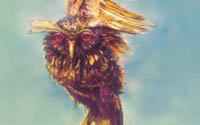BLACK MAGIC BEHIND ILLEGAL OWL TRADE IN INDIA
by Chantal Cooke
The use of owls in black magic and sorcery driven by superstition, totems and taboos is one of the prime drivers of the covert owl trade – that according to TRAFFIC India after their investigation into the illegal trade, trapping and utilization of owls in India.
TRAFFIC India’s report entitled “Imperilled Custodians of the Night” was launched by Shri Jairam Ramesh, Hon. Minister of Environment and Forests at his office in New Delhi.
Hunting of and trade in all Indian owl species is banned under the Wildlife (Protection) Act 1972 of India.
While the exact number of owls traded each year countrywide is unknown, it certainly runs into thousands of individuals and there are anecdotal reports of owls becoming rare throughout India due to loss of suitable habitat especially old growth forests.
In light of such reports, TRAFFIC is calling for measures including better law enforcement to curb the trade in owls immediately.
TRAFFIC also calls for raising awareness of the beneficial and vital role of owls in the ecosystem, the birds being of particular benefit to farmers through their predation of rodents and other crop pests.
Shaman or black magic practitioners frequently referred to as tantriks in India, prescribe the use of owls and their body parts such as skull, feathers, ear tuffs, claws, heart, liver, kidney, blood, eyes, fat, beak, tears, eggshells, meat and bones for ceremonial pujas and rituals.
Of the 30 owl species recorded from India, 15 have been recorded by this study in the domestic live bird trade. Owl species most highly sought after by traders are large species, especially those with false “ear-tufts” (actually feather extensions on the head), which are thought to bestow greater magical properties on the birds.
However, trade includes both large (e.g. Rock Eagle-Owl) & small (e.g. Spotted Owlet) owl species inhabiting areas as varied as urban settings and forest or riverine tracts with the main centres for the illicit trade located in Uttar Pradesh, Madhya Pradesh, West Bengal, Andhra Pradesh, Delhi, Gujarat, Rajasthan and Bihar, according to TRAFFIC.
Shri Jairam Ramesh, Hon. Minister of Environment and Forest said at the launch, “Diwali should be a time for celebration across our nation, not one when our wildlife is plundered to feed ignorant superstition. India’s wildlife already faces many pressures; the additional burden of being killed out of ignorance and fear is not one that has any place in our modern society”.
“Owls are as important to our ecosystem as the Tigers or any other better known charismatic species. It is important that the threat to owls is brought to light during the festival of Diwali and concrete ground action is undertaken to curb such trade” he further added.
The TRAFFIC investigation also finds that besides black magic, owls are trapped and traded for use in street performances; killed for taxidermy and for their meat; their parts are used in folk medicines; even their claws and feathers are sometimes used in headgear. Live owls are also used as decoys to catch other bird species.
The full report can be downloaded at: http://www.traffic.org/species-reports/traffic_species_birds12.pdf
For more information visit www.trafficindia.org or www.traffic.org

